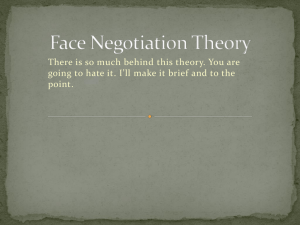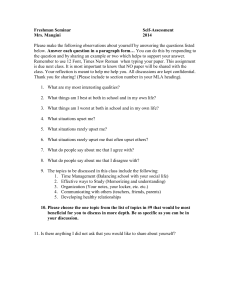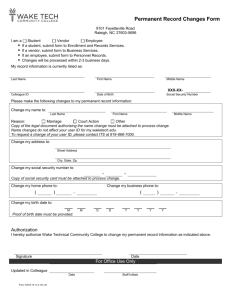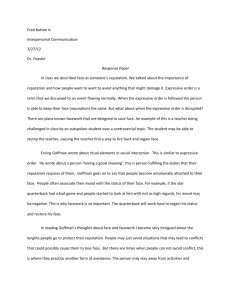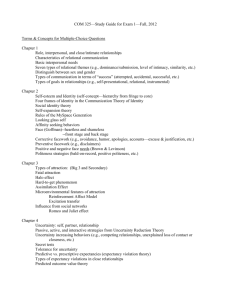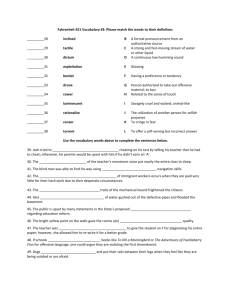Effective Communication: Strategies for Interpersonal
advertisement
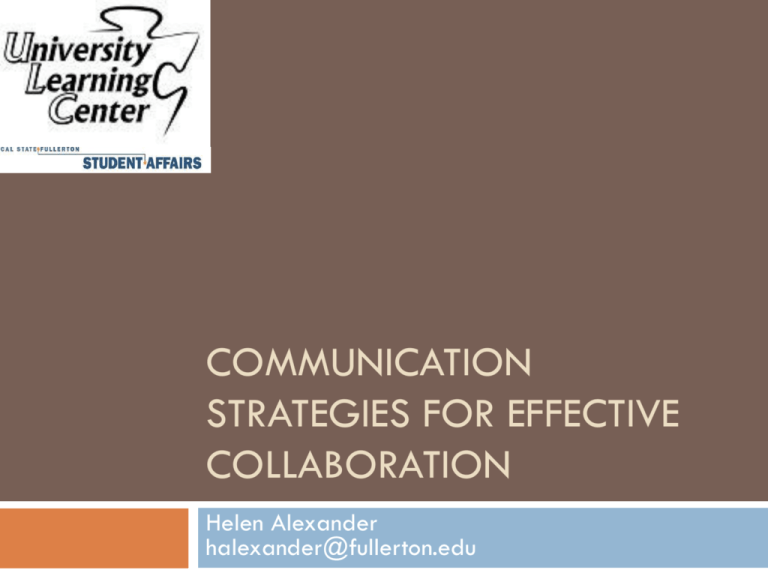
COMMUNICATION STRATEGIES FOR EFFECTIVE COLLABORATION Helen Alexander halexander@fullerton.edu Objectives To raise awareness of one’s own expectations and definitions of, and preferences for, collaborative communication To discuss factors that affect perceptions about effective and/or appropriate communicative interactions To explore strategies for creating an effective framework for collaboration, as well as strategies for recognizing and reconciling misunderstandings Scenarios I: Your colleague constantly refers to you as “bro” even in meetings with others present. You need some information to complete a report due to your supervisor on Friday. Your colleague who has the info hasn’t returned any of your emails. When you do get a hold of her, she said she thought it was due the week after, so she had been working on something due for her supervisor this week. You’ve been working on part of a project for three weeks. When you arrive at the meeting, you are told that your work doesn’t address the needs of the project. Things to Bear in Mind: How Do YOU Define These Terms? Communication is . . . to a purpose: Why are we here? What is my role? What are MY pet peeves? Collaboration is . . . an equal contribution according to our strengths: Who are the players? What is the desired outcome? What is our timeframe? The Interpersonal Aspect Face-to-Face versus Written Communication Margin for error Agreeing on the protocol Respecting the expectations of all involved regarding: Language Medium Purpose Pragmatics Strategies for Effective Communication Raising Awareness Negotiation of Meaning Facework Habitual Clarification Raising Awareness Linguistic disconnect What is the most polite way to address your colleague? To disagree? To interject? Paralinguistic disconnect What does this gesture mean? Socio-cultural disconnect What is the first thing to be discussed? The last thing? What kind of content information would be useful? Negotiation of Meaning A term used often in Second Language teaching, this is where two or more persons determine what is being discussed and how by a series of exchanges. Collaborators often bring different visions of the final product to a project. Discussing the desired outcome from the outset and working toward a common vision can often improve productivity and cut down on heated debates. Never be afraid to ask questions, and reformulate until you get the answers you need! Asking the “right” questions. What do you think? What do we want to accomplish? What do we need to do to reach our goal? Scenarios II: You have a colleague that, every time you ask a question, he responds with a story or tells you about something he read recently related to the topic. You ask your colleagues a question about what is wanted on a project, and you get three different responses. You ask a question about what should be done, and based on the answer you receive, you go ahead. Later the person who gave you the answer denies telling you that and thinks something different should have been done. Strategies for Negotiating Meaning Inclusive Language Avoid Negative Language Treat this like the group-effort it is. Avoid responses that seem to center on your view. Contradictions are rarely helpful, and often misunderstood. Use Three-Way Communication A common safety protocol that can be used to good effect in most high-risk miscommunication contexts. 1. Listen for meaning until the speaker has completed the thought. 2. Rephrase or summarize the utterance for accurate comprehension. 3. Respond to the idea accordingly. Facework Facework is a term used in many fields. For our purposes, it will refer to the extra-context elements of interpersonal interaction that are necessary to maintaining a positive group dynamic. Elements of facework that come into play in collaboration include: Face-threatening acts. Value assumptions. Humor or sharing personal details. Scenarios III: A colleague tells an off-color joke and every else laughs. Another team member doesn’t have all of the data prepared for the meeting. The team leader asks him what he was doing for two weeks in front of everyone. Your colleagues, who are all single, set a meeting for 5:30 p.m. on a Tuesday. Strategies to Maintain Face Use effective word choice. Challenge versus Problem (Russell, 2004) Focus on the objectives decided by the group. Praise good work done by each individual. Keep it professional. Don’t allow anyone to be singled out. Find creative ways to deal with perceived failings. Determine if there was a misunderstanding about what was wanted. Swap tasks to see if there’s a better fit. Determine if the task could be done another way. Reexamine the desired outcome and brainstorm new ways to get there. Habitual Clarification Our memories often play tricks on us, and we remember what WE think we were supposed to do, and not what was expected of us. Ways to stay on task include: Frequent notes or requests for clarification. When in doubt, ask! A log—email, memo, or other written document—that all members of the group have access to. A chart with the steps clearly outlined and completion dates. Planned meetings or check-in points. Sometimes there is nothing to be done until one part of the project is complete. It’s still worthwhile to bolster up the “face” and participate by encouragement/interest. When it All Breaks Down Emotional Backlash Discomfort often founded in an unintentional slight. Personality Conflict Perceptions of the world and how to communicate in it can be influenced by: Family Field Society Culture Other Taking a Step Back Coping strategies begin with awareness that something has gone wrong, and the ability to step back from the personal discomfort and view the situation dispassionately. There are two perspectives: Recognize that someone else is upset. Body language Tone of voice/word choice Attitude Recognize YOU are upset. Discomfort or irritation with someone or something said. Strategies for communication breakdown: He looks upset…. Be direct. Often people don’t realize what has bothered them—they just perceive that somehow you’ve been disrespectful. Force them to address that feeling or concern. Be honest. Especially if English isn’t your first language, this isn’t your field of study, or you’ve had a hard time getting the hang of the context, let them know that perhaps you made a mistake. Ask them to help you pinpoint it. You don’t have to lose face to say, “Perhaps I didn’t word that the best way. Maybe I need a bit more coffee. Could you tell me what you understood, and I’ll see if I can clarify my idea?” Sometimes nothing is bothering them but a headache, and this concern becomes attention to their personal well-being. Thoughtful people make good collaborators. Strategies for communication breakdown: I’M upset…. Do NOT respond. Take a minute and decide WHY you feel upset. The words they used? They weren’t polite? Must I fill this out? They presumed upon your time or good will? You look short. I know you will help me study. ALWAYS assume they didn’t mean it. Give them the benefit of the doubt, and give them a chance to try again. Use 3-Way-Communication, rephrasing it as would make more sense in the conversation before the disconnect. “You want to know if you need to complete this form, right?” In Essence Especially for situations where a high level of interpersonal difference can cause points for misunderstanding, facework and the need for written reinforcement should be stressed. Awareness of one’s own understanding of how to communicate, and the other ways that are possible, can help keep collaboration a creative and open process. Agreed-upon protocols and clearly defined terms and goals will go a long way when collaborating in interdisciplinary or intercultural contexts. Some Interesting Reading Pauline, F., & Amy Snyder, O. (2005). Negotiation for meaning and peer assistance in second language classrooms. Applied Linguistics, 26(3), 402-430. Retrieved from EBSCOhost. Why Clare. (2010, Jan. 28) Three-way communication. Retrieved from http://whyclare.wordpress.com/2010/01/28/three-waycommunication/ Russell, N. (2004). Winning at work: Words. Words. Words. Retrieved from http://superperformance.com/words.php Arundale, R. B. (2010). Constituting face in conversation: Face, facework, and interactional achievement. Journal of Pragmatics, 42(8), 2078-2105. doi:10.1016/j.pragma.2009.12.021
